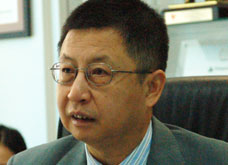 Executive chairman Wong Lam Ping intends to develop commercial leisure real estate in Hangzhou, which bustles with tourism and shopping districts.
Executive chairman Wong Lam Ping intends to develop commercial leisure real estate in Hangzhou, which bustles with tourism and shopping districts.
CIMB maintained its 'Buy' call on Pan Hong and target price of 88 cents after an update by its executive chairman Wong Lam Ping at a teleconference attended by NextInsight yesterday.
CIMB analyst Gary Ng's fair value for the real estate developer discounts up to 20% of Pan Hong's adjusted net asset value, and translates into a 76% upside to its last closing price of 50 cents.
Three factors in Pan Hong's favor, according to the analyst:
1) Real estate prices are expected to recover
2) Margins are likely to improve as Pan Hong speeds up project launches
3) It will acquire land more aggressively
Real estate prices in China’s second and third tier cities are likely to continue its uptrend, said Dr Wong at the telecon.
He believes government curbs on housing speculation curbs will ease by next year, when affordable public housing will be available to the lower income group.
As case in point, the real estate developer is reaping a windfall exceeding 50% in asset value gains when it returned a plot of industrial land located in a second tier city in Zhejiang to authorities after a year’s investment.
It had been developing a warehousing center in Pinghu city at Dushan Port, with investment to-date amounting to Rmb 53.7 million.
On 1 Nov, it withdrew from the project in return for a total compensation of Rmb 81.5 million from the PRC government.
|
Subsidiary listing to unlock shareholders value
Pan Hong’s land bank exceeds two million square meters, with book value at cost exceeding one billion yuan. This is evenly divided between the two provinces of Jiangxi and Zhejiang.
On 25 Oct 2010, it announced its intention to spin off its residential and commercial property development businesses in Jiangxi for a primary listing in Hong Kong.
Pan Hong focuses on second-tier and third-tier cities, and Dr Wong is upbeat about growing speculative demand for real estate there, which is now seen by investors as having better potential for asset appreciation compared to first tier cities.
According to Dr Wong, there are few property companies with land banks as large as Pan Hong’s in second tier cities that are provincial capitals, and he believes the IPO will attract strong institutional interest from property players.
Pan Hong’s second quarter revenues for the financial year ending Mar 2011 multiplied 9-fold (up 816.0%) and reached Rmb 115.2 million, thanks to the recognition of more residential units and sales of car part lots at its commercial cum residential developments (Hangzhou Liyang Yuan and Nanchang Honggu Kaixuan Phase 2).
It sold 44 of 222 units at Hangzhou Liyang Yuan and 99 of 844 units at Nanchang Honggu Kaixuan Phase 2, but revenues accrued include units sold in previous quarters but delivered only in 2Q11.
Gross profit margin slid by 12.4 percentage points to 30.4%. Margins were thinner as car park lots at Hangzhou Liyang Yuan are not as lucrative as home sales.
Higher finance cost and land appreciation tax trimmed profit attributable to shareholders to Rmb 22.9 million (down 3.4%). Net margins were 19.8%.
Related stories:
PAN HONG: 1Q2011 revenues up 269.9% at Rmb 88.2 million
PAN HONG multiplies top line 10X despite China’s austere property curbs







